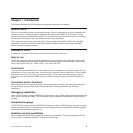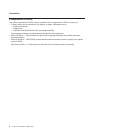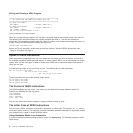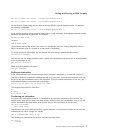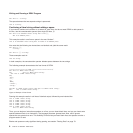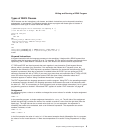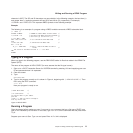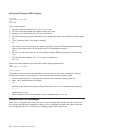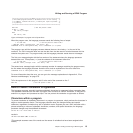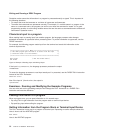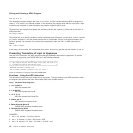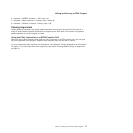
Label
A label, such as sub: is a symbolic name followed by a colon. A label can contain either single- or
double-byte characters or a combination of single- and double-byte characters. (Double-byte characters
are valid only if OPTIONS ETMODE is the first instruction in your program.) A label identifies a portion of
the program and is commonly used in subroutines and functions, and with the SIGNAL instruction. (Note
that you need to include a RETURN instruction at the end of a subroutine to transfer control back to the
main program.) More about the use of labels appears in Chapter 6, “Writing Subroutines and Functions,”
on page 57 and section “SIGNAL Instruction” on page 50.
Null Clause
A null clause consists of only blanks or comments or both. The language processor ignores null clauses,
but they make a program easier to read.
Comments
A comment begins with /* and ends with */. Comments can be on one or more lines or on part of a
line. You can put information in a comment that might not be obvious to a person reading the
REXX instructions. Comments at the beginning of a program can describe the overall purpose of
the program and perhaps list special considerations. A comment next to an individual instruction
can clarify its purpose.
Note: REXX/CICS does not require that a REXX program begin with a comment. However, for
portability reasons, you may want to start each REXX program with a comment that
includes the word REXX.
Not every language processor requires this program identifier. However, to run the same exec on
MVS TSO and CICS, you should include the /* REXX */ program identifier to satisfy TSO
requirements.
Blank lines
Blank lines separate groups of instructions and aid readability. The more readable a program is,
the easier it is to understand and maintain.
Commands
A command is a clause consisting of only an expression. Commands are sent to a previously defined
environment for processing. (You should enclose in quotation marks any part of the expression not to be
evaluated.) The example program did not include any commands. The following example includes a
command in an ADDRESS instruction:
/* REXX program including a command */
ADDRESS REXXCICS 'DIR'
ADDRESS is a keyword instruction. When you specify an environment and a command on an ADDRESS
instruction, a single command is sent to the environment you specify. In this case, the environment is
REXXCICS. The command is the expression that follows the environment:
'DIR'
The DIR command lists the files in your current file system directory. For more details about changing the
host command environment, see section “Changing the Host Command Environment” on page 83.
More information about issuing commands appears in Chapter 8, “Using Commands from a program,” on
page 81.
Programs Using Double-Byte Character Set Names
You can use double-byte character set (DBCS) names in your REXX programs for literal strings, symbols,
and comments. Such character strings can be single-byte, double-byte, or a combination of both. To use
DBCS names, OPTIONS ETMODE must be the first instruction in the program. This specifies that the
language processor should check strings containing DBCS characters for validity. You must enclose DBCS
characters within shift-out (SO) and shift-in (SI) delimiters. (The SO character is X'0E', and the SI
Writing and Running a REXX Program
10
CICS TS for VSE/ESA: REXX Guide




